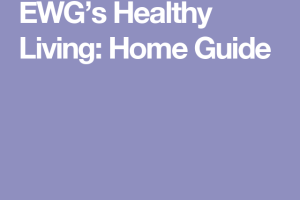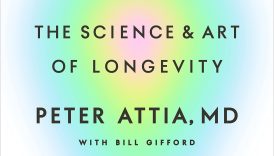Achieving Optimal Health with EWG’s Expert Advice

Introduction to EWG’s Expert Advice
Understanding the Environmental Working Group (EWG)
The Environmental Working Group (EWG) is a beacon of hope in a world where chemicals permeate our daily lives. Founded in 1993, EWG has garnered a reputation as a trusted non-profit organization dedicated to empowering individuals to live healthier and safer lives through informed choices. By conducting extensive research on various products and chemicals, EWG aims to provide valuable insights into the risks posed by everyday items. At the core of EWG’s mission is the belief that everyone has the right to know what they are putting into their bodies and homes. EWG’s databases, such as the Skin Deep Cosmetics Database and the Food Scores, offer easy-to-understand ratings and reviews on thousands of products, enabling consumers to make educated decisions. This transparency is particularly crucial in an age where marketing claims can often overshadow scientific reliability.
- Achieving Optimal Health with EWG’s Expert Advice
- Introduction to EWG's Expert Advice
- Understanding the Environmental Working Group (EWG)
- Importance of Seeking Expert Health Advice
- The Impact of Toxins on Health
- Identifying Harmful Toxins in Everyday Products
- Health Risks Associated with Toxin Exposure
- Building a Non-Toxic Home Environment
- Tips for Creating a Chemical-Free Living Space
- Safe Cleaning Practices for Optimal Health
- Nourishing Your Body with Clean Eating
- Benefits of Organic and Non-GMO Foods
- EWG's Guide to Healthy Eating Choices
- Choosing Safe Personal Care Products
- Understanding Toxic Ingredients in Beauty Products
- EWG's Verified List of Safe Personal Care Items
Importance of Seeking Expert Health Advice
When it comes to health, expert advice is essential. In today’s complex world filled with confusing labels and marketing buzzwords, without adequate knowledge, individuals can inadvertently expose themselves to harmful toxins. This is where EWG shines—taking the guesswork out of choosing safe products. Consider an example: Maria, a new mom, wanted to ensure her household was safe for her newborn. By utilizing EWG’s resources, she discovered that many common cleaning products contain harsh chemicals that could adversely affect her family’s health. By switching to EWG-verified products, she felt empowered to create a non-toxic environment for her child. Here are a few reasons why seeking expert health advice through EWG is important:
- Reliable Information: EWG provides scientifically-backed data that demystifies the effects of various chemicals.
- Empowerment: Understanding the risks associated with everyday products empowers consumers to make choices aligned with their health goals.
- Safer Choices: With easy access to verified options, individuals can choose products that protect their health and the environment.
In a world filled with choices, turning to EWG for expert advice offers a path toward a healthier, safer lifestyle.
The Impact of Toxins on Health
Identifying Harmful Toxins in Everyday Products
As we strive for a healthy lifestyle, it’s crucial to recognize the harmful toxins hidden in everyday products. From the personal care items we apply to our skin to the cleaners we use around the house, many products contain ingredients that can pose health risks. For instance, common household items such as:
- Cosmetics: Many lipsticks and foundations can contain lead and parabens, which have been linked to hormonal disruptions.
- Cleaning Supplies: Some all-purpose cleaners include quaternary ammonium compounds that may contribute to respiratory problems.
- Food Packaging: Certain plastics contain bisphenol A (BPA), which can leach into foods and beverages, potentially affecting metabolism.
Recognizing and understanding these toxins is the first step in protecting our health. The Environmental Working Group has made significant efforts to educate consumers by creating databases that offer insights into which products may contain harmful substances. Employing these resources allows individuals to make informed choices about the products they use daily.
Health Risks Associated with Toxin Exposure
The health implications of exposure to these toxins can be significant and alarming. Prolonged contact with harmful substances can lead to a range of adverse effects. For example, Sarah, a health-conscious individual, noticed an increase in allergic reactions and persistent fatigue after using conventional cleaning products. After switching to EWG-verified alternatives, her symptoms began to improve, highlighting the real impact of toxin exposure. Here are some common health risks associated with everyday toxins:
- Hormonal Disruption: Ingredients like phthalates found in fragrances can interfere with endocrine function.
- Respiratory Problems: Many cleaning agents can exacerbate asthma or cause other respiratory issues.
- Carcinogenic Effects: Chemicals such as formaldehyde are linked to an increased risk of certain cancers.
It’s essential to consider the cumulative effect of long-term exposure to multiple toxins. By addressing the sources of these harmful substances, individuals can significantly reduce the risks associated with toxin exposure. Taking proactive steps toward a cleaner, non-toxic environment is not just a choice; it’s a powerful investment in long-term health.
Building a Non-Toxic Home Environment
Tips for Creating a Chemical-Free Living Space
Creating a chemical-free living space is not just a trend; it’s a necessity for maintaining optimal health in today’s toxin-laden environment. Every day, we interact with products that may carry harmful ingredients, but thankfully, there are simple steps to build a safer, non-toxic home. For example, after learning about the risks associated with conventional air fresheners, Jennifer decided to eliminate them from her home. Instead, she opted for natural alternatives like essential oil diffusers and houseplants, which not only freshen the air but also beautify her space. Here are some other tips to consider:
- Choose Natural Materials: Opt for organic cotton bedding, bamboo furniture, and non-toxic paints. Materials free from harmful chemicals create a safer environment.
- Ventilation is Key: Regularly open windows to improve air circulation, reducing indoor air pollutants and allowing fresh air to seep in.
- DIY Cleaning Products: Make your own cleaning solutions using simple ingredients like vinegar, baking soda, and lemon juice. Not only are these effective, but they’re also safe for you and the planet.
Safe Cleaning Practices for Optimal Health
When it comes to maintaining a clean home, the products you choose matter immensely. Those toxic labels often found on cleaning bottles can lead to unwanted health concerns. Transitioning to safe cleaning practices is a pivotal step in creating a non-toxic home. Here’s a simple cleaning regimen that prioritizes health:
- Daily Declutter: Reducing the number of items in your home can minimize dust and allergens, making it easier to maintain cleanliness.
- Natural Disinfectants: Use diluted hydrogen peroxide or white vinegar as effective disinfectants without the harmful effects of conventional products.
- Focus on High-Traffic Areas: Instead of overusing harsh chemicals, target high-traffic areas such as kitchens and bathrooms with biodegradable cleaners that are tough on germs yet gentle on your family.
Shifting to safe cleaning practices not only protects your health but also improves overall well-being. By consciously choosing greener alternatives and eliminating harmful products, you create a harmonious space that promotes health and happiness for you and your loved ones. Remember, every small change counts towards a non-toxic home!
Nourishing Your Body with Clean Eating
Benefits of Organic and Non-GMO Foods
Transitioning to a clean eating lifestyle is not only about making healthier choices—it’s also about understanding what goes into our food. One significant aspect is opting for organic and non-GMO (genetically modified organisms) foods. These choices elevate the quality of what we put on our plates and have several compelling benefits. Growing up, Alex used to enjoy foods from the conventional supermarket aisle without considering what they contained. However, after learning about the advantages of organic foods, he made a switch. Here’s what he found:
- Fewer Chemicals: Organic foods are grown without synthetic pesticides and fertilizers, meaning you’re less likely to consume harmful chemicals that potentially disrupt hormonal balance.
- Greater Nutritional Value: Research suggests that organic produce may have higher levels of antioxidants, vitamins, and minerals than its conventionally grown counterparts.
- Environmental Benefits: Choosing non-GMO and organic foods supports sustainable farming practices, helping to preserve biodiversity and reduce pollution.
Switching to organic and non-GMO foods is not merely a trend—it’s an investment in one’s health and the planet.
EWG’s Guide to Healthy Eating Choices
To make informed and healthy food choices, many people turn to the resources offered by the Environmental Working Group. EWG’s guide simplifies the process, empowering consumers to select products that promote well-being. One way EWG does this is through its annual “Dirty Dozen” list. This list outlines produce items that are most likely to retain pesticide residues, providing guidance on what to buy organic versus conventional. Consider these items on the latest list:
- Strawberries
- Spinach
- Kale
- Apples
EWG also emphasizes the importance of sustainability by encouraging the consumption of seasonal, local, and organic products whenever possible. Additionally, their Food Scores database rates foods based on nutrition, ingredient concerns, and processing levels, making it easier to choose healthier options. Integrating EWG’s insights into everyday meal planning can significantly enhance the quality of your diet. By opting for organic and non-GMO foods and utilizing EWG’s resources, you can nourish your body and embrace the holistic journey toward improved health. Clean eating is not just about what you eat; it’s about making conscious, educated choices that positively impact your life and the environment.
Choosing Safe Personal Care Products
Understanding Toxic Ingredients in Beauty Products
When it comes to personal care, many individuals may not realize that the products they use daily—like shampoos, lotions, and makeup—can contain toxic ingredients that pose health risks. For example, while getting ready for a night out, Lucy loved using her favorite mascara, unaware that it contained phthalates and parabens, which have been linked to hormonal disruptions and potential long-term health issues. Identifying these harmful ingredients can be daunting, especially given the confusing labels and marketing claims used by many brands. Here are some common toxic ingredients often found in beauty products that consumers should be wary of:
- Parabens: Used as preservatives, parabens can disrupt hormone function.
- Fragrance: Often a hidden mix of harmful chemicals, fragrances can trigger allergies and sensitivities.
- Formaldehyde: A known carcinogen found in some hair treatments and nail products.
- Sodium Lauryl Sulfate (SLS): A surfactant that can irritate the skin and eyes.
Awareness is the first step towards making safer choices. Reading labels carefully and researching products can help consumers avoid harmful chemicals in their personal care routines.
EWG’s Verified List of Safe Personal Care Items
To simplify the process of choosing safe beauty products, the Environmental Working Group (EWG) offers a verified list of personal care items. By scrutinizing the safety and effectiveness of various products, EWG provides consumers with trustworthy recommendations. For instance, Jessica, who was initially overwhelmed by the daunting task of replacing her conventional beauty products, turned to EWG’s verified list for guidance. After discovering safe options for her skincare routine, she felt peace of mind knowing that her daily regimen was free from harmful toxins. The benefits of using EWG’s verified products include:
- Safety Assurance: Each product on the list meets EWG’s strict guidelines for safety and transparency.
- Simplified Choices: The verified label makes it easier to identify safe options in stores.
- Peace of Mind: Knowing you’re using products without harmful ingredients alleviates concerns about long-term exposure.
Incorporating EWG’s verified personal care items into your daily routine is a powerful way to protect your health. Ultimately, choosing safe beauty products means investing in yourself, ensuring that the products you use to enhance your beauty are not only effective but also safe for your body. Clean choices lead to a cleaner, healthier lifestyle.





